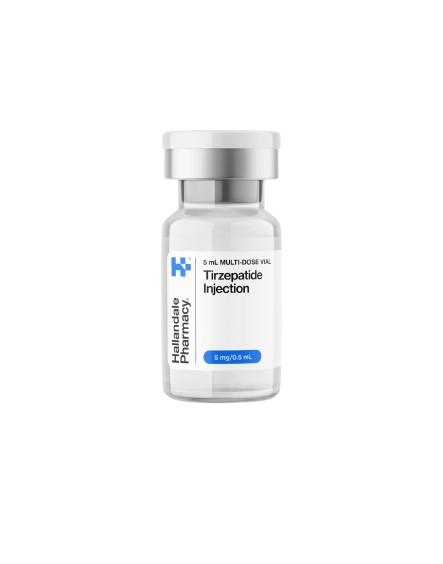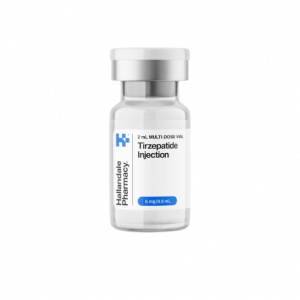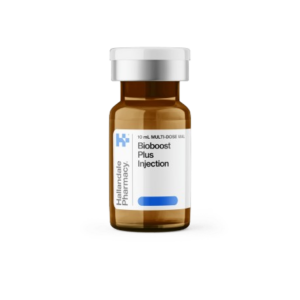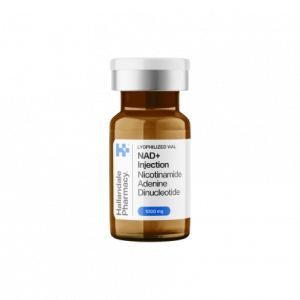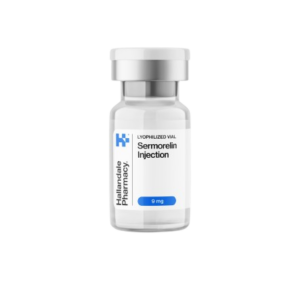Compounded Tirzepatide 10mg/ml 5ML vial
Original price was: $639.00.$629.00Current price is: $629.00.
- 10mg/ml; 5ml Vial
- Requires refrigeration
- Syringes and alcohol prep pads included
- Overnight shipping included
- Healthcare provider contact within 24 hours of purchase if more information needed (will not be charged unless prescribed).
Description
Tirzepatide is a medication used primarily for the treatment of type 2 diabetes and, more recently, for weight management. It is a dual GIP and GLP-1 receptor agonist, which means it works by mimicking two natural hormones—glucose-dependent insulinotropic peptide (GIP) and glucagon-like peptide-1 (GLP-1)—to help regulate blood sugar and support weight loss.
How it works:
- Regulates blood sugar: Tirzepatide helps lower blood sugar levels by stimulating insulin release when blood glucose is high, reducing glucose production by the liver, and slowing down gastric emptying (which helps you feel fuller for longer).
- Supports weight loss: It also has appetite-suppressing effects, helping individuals with type 2 diabetes lose weight by making them feel less hungry and reducing food intake.
Common uses:
- Type 2 Diabetes: Tirzepatide helps improve blood sugar control, often when other medications have not been sufficient.
- Obesity/Weight Management: Tirzepatide is also approved under the brand name Mounjaro for weight loss in adults with obesity or overweight individuals with at least one weight-related health condition (e.g., high blood pressure, high cholesterol, etc.).
Tirzepatide dosing schedule typically starts with a lower dose and gradually increases every 4 weeks to reduce side effects and allow the body to adjust. If your appetite is suppressed at any of the 4 week increments, you can delay increasing the next titrated dose or stay at the lowest effective dose that gives you results without undesired side effects.
| Week | Tirzepatide Dose | Injection Frequency |
|---|---|---|
| 1 | 2.5 mg (25 units on syringe) | Once a week |
| 2 | 2.5 mg | Once a week |
| 3 | 2.5 mg | Once a week |
| 4 | 2.5 mg | Once a week |
| 5 | 5 mg (50 units on syringe) | Once a week |
| 6 | 5 mg | Once a week |
| 7 | 5mg | Once a week |
| 8 | 5mg | Once a week |
| 9 | 7.5 mg (75 units on syringe) | Once a week |
| 10 | 7.5 mg | Once a week |
| 11 | 7.5 mg | Once a week |
| 13+ | 10 mg (or adjust based on provider’s recommendation) | Once a week |
Key benefits:
1. Improved Blood Sugar Control (Type 2 Diabetes)
- Regulates Blood Glucose: Tirzepatide helps lower blood sugar levels by improving insulin sensitivity and reducing the amount of glucose produced by the liver.
- Reduces HbA1c: It has been shown to significantly lower HbA1c levels (a measure of long-term blood glucose control).
2. Weight Loss
- Reduces Appetite: Tirzepatide can help reduce appetite, leading to lower food intake.
- Promotes Fat Loss: Studies have demonstrated significant weight loss in people with obesity or overweight, helping with overall body composition.
- Effective for Weight Management: For individuals with obesity, tirzepatide has been shown to achieve meaningful and sustained weight loss.
3. Improved Cardiovascular Health
- Reduces Risk of Cardiovascular Events: Some studies suggest tirzepatide may help reduce the risk of heart-related issues, such as stroke and heart attack, in people with diabetes and obesity.
- Improves Blood Pressure and Cholesterol: It can help in reducing blood pressure and improving lipid profiles, which are important factors in heart health.
4. Convenient Once-Weekly Injection
- Ease of Use: Tirzepatide is administered once a week via subcutaneous injection, which is more convenient than daily medications, improving patient adherence.
5. Potential Benefits for Other Metabolic Conditions
- Improves Liver Health: Some evidence suggests tirzepatide may help in managing fatty liver disease, a common condition in individuals with type 2 diabetes and obesity.
- Reduces Inflammation: It may help reduce inflammation, which is often elevated in metabolic diseases like diabetes.
6. Minimal Risk of Hypoglycemia
- Low Risk of Low Blood Sugar: Tirzepatide is associated with a low risk of hypoglycemia (low blood sugar), especially when used alone without other medications that cause hypoglycemia.
7. Better Overall Quality of Life
- Improves Energy and Vitality: Weight loss and better blood sugar control often lead to improved energy levels, making daily activities easier and enhancing overall quality of life.
Tirzepatide is a once a week subcutaneous injection, typically injected into the abdomen, thigh, or upper arm.
-
Prepare the Injection:
- Wash your hands thoroughly.
- Gather all necessary supplies (medication, syringe/pen, needle, alcohol swab, and a gauze or bandage).
-
Select Injection Site:
- Common sites are the abdomen (avoiding 2 inches around the belly button) or the upper thigh.
- Clean the chosen area with an alcohol swab and let it dry.
-
Prepare the Syringe:
- Draw the prescribed dose of medication.
-
Pinch the Skin:
- Gently pinch the skin of the injection site to lift it away from the muscle.
-
Insert the Needle:
- Hold the syringe like a pencil and insert the needle at a 45 to 90-degree angle.
-
Inject the Medication:
- Slowly press the plunger or button to inject the medication.
- Hold the needle in place for a few seconds to ensure the full dose is delivered.
-
Withdraw the Needle:
- Pull the needle out quickly and apply gentle pressure with a clean gauze or cotton ball.
-
Dispose of the syringe:
- Dispose of the syringe in a puncture-proof container.
Dosing Schedule:
Tirzepatide dosing schedule typically starts with a lower dose and gradually increases every 4 weeks to reduce side effects and allow the body to adjust. If your appetite is suppressed at any of the 4 week increments, you can delay increasing the next titrated dose or stay at the lowest effective dose that gives you results without unwanted side effects.
| Week | Tirzepatide Dose | Injection Frequency |
|---|---|---|
| 1 | 2.5 mg (25 units on syringe) | Once a week |
| 2 | 2.5 mg | Once a week |
| 3 | 2.5 mg | Once a week |
| 4 | 2.5 mg | Once a week |
| 5 | 5 mg (50 units on syringe) | Once a week |
| 6 | 5 mg | Once a week |
| 7 | 5 mg | Once a week |
| 8 | 5mg | Once a week |
| 9 | 7.5 mg (75 units on syringe) | Once a week |
| 10 | 7.5mg | Once a week |
| 11 | 7.5mg | Once a week |
| 13+ | 10 mg (or adjust based on provider’s recommendation) | Once a week |
Tirzepatide is generally well-tolerated, but like all medications, it can cause side effects. Here are some of the most common and potential side effects:
Common Side Effects:
-
Gastrointestinal Issues:
- Nausea: This is one of the most common side effects, especially when starting the medication or increasing the dose.
- Vomiting: Some people may experience vomiting, particularly in the early stages.
- Diarrhea: Can occur along with nausea.
- Constipation: Less common, but can occur in some individuals.
- Abdominal Pain: Discomfort or pain in the stomach area is also reported by some people.
-
Decreased Appetite:
- As tirzepatide works to reduce appetite (a benefit for weight loss), some people may experience reduced hunger levels, which can lead to weight loss.
-
Fatigue:
- Some users report feeling more tired or fatigued, particularly early on in treatment.
Serious Side Effects:
-
Pancreatitis (Inflammation of the Pancreas):
- Symptoms: Severe abdominal pain, nausea, and vomiting. If you experience these symptoms, seek medical help immediately.
- This is a rare, but serious side effect. Those with a history of pancreatitis should discuss the risks with their doctor.
-
Thyroid Tumors (including thyroid cancer):
- Rare Risk: Animal studies have shown a potential risk of thyroid tumors, but it’s unclear if this applies to humans.
- Symptoms: Lump or swelling in the neck, difficulty swallowing, or hoarseness.
- This is a very rare side effect, but it’s something to discuss with your healthcare provider, especially if you have a family history of thyroid cancer.
-
Kidney Issues:
- In some cases, tirzepatide can affect kidney function. Symptoms may include changes in urine output or swelling in the legs and feet.
- Kidney problems are usually more likely to occur in people who already have kidney disease.
-
Severe Allergic Reactions:
- Symptoms of a serious allergic reaction can include swelling of the face, lips, tongue, or throat, which can cause difficulty breathing. If this occurs, immediate medical attention is necessary.
-
Hypoglycemia (Low Blood Sugar):
- While tirzepatide has a lower risk of causing low blood sugar on its own, the risk increases if taken with other medications, such as insulin or sulfonylureas.
- Symptoms: Sweating, shaking, dizziness, and confusion.
-
Gallbladder Issues:
- Gallstones: There is some evidence that tirzepatide may increase the risk of gallbladder problems, including gallstones, in some individuals.
Other Potential Side Effects:
- Injection Site Reactions: Redness, swelling, or irritation at the injection site.
- Headache: Some people may experience headaches as a side effect.
Important Considerations:
- Pregnancy and Breastfeeding: Tirzepatide is not recommended during pregnancy or breastfeeding unless specifically prescribed by a doctor.
- Pre-existing Conditions: People with a history of certain conditions, like pancreatitis or thyroid issues, should consult with their doctor before starting tirzepatide.

